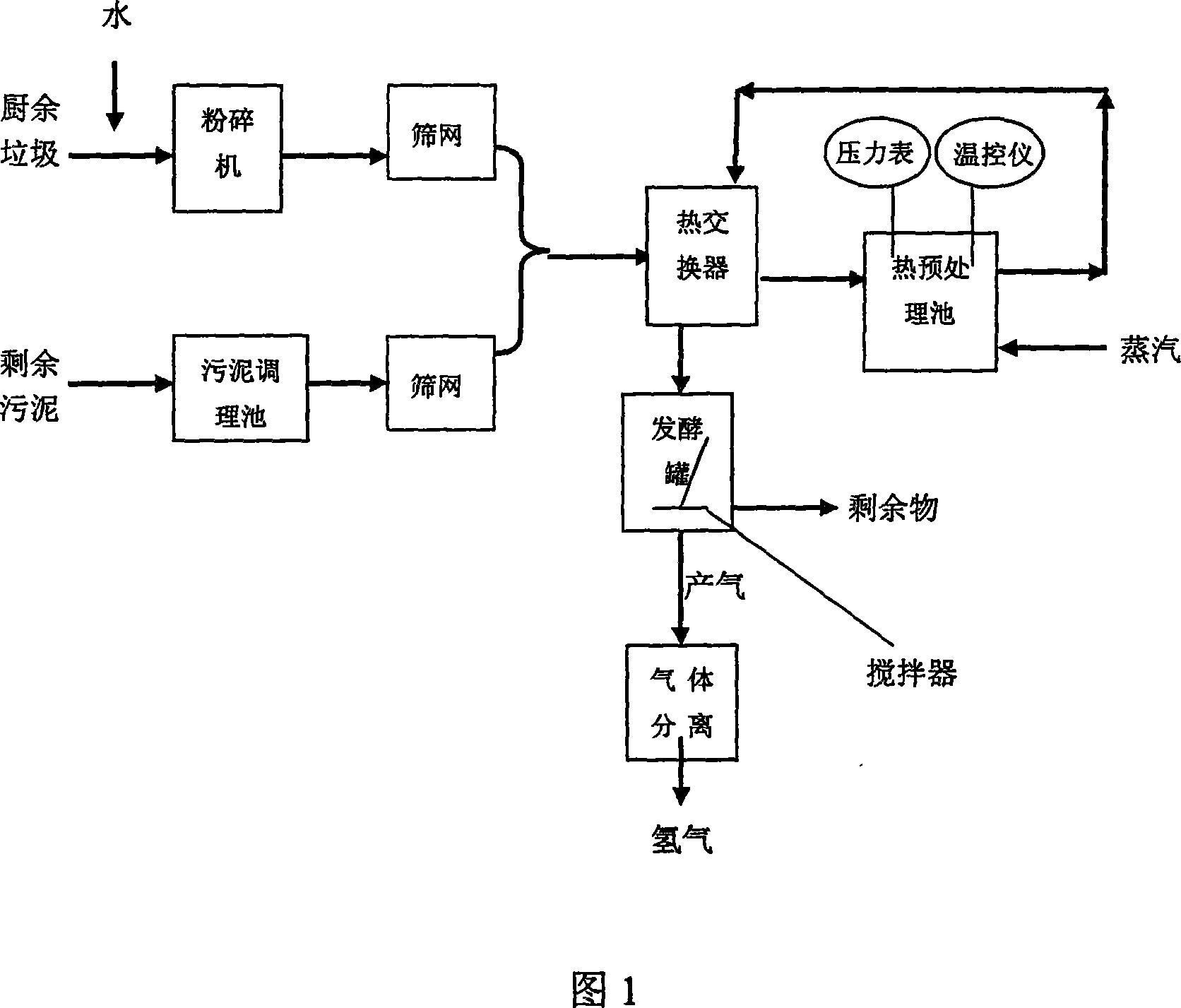Kitchen residual garbage normal temperature anaerobic fermentation method
A technology of kitchen waste and anaerobic fermentation, which is applied in the direction of fermentation, etc., can solve the problems of reduced gas production effect, large initial investment, and long fermentation cycle, and achieves strong tolerance, low operating cost, and reduced energy consumption.
- Summary
- Abstract
- Description
- Claims
- Application Information
AI Technical Summary
Problems solved by technology
Method used
Image
Examples
Embodiment 1
[0030] Composition of kitchen waste: rice noodle products: vegetables: meat = 6:3:1; room temperature conditions: 24-28°C during the day and 15-20°C at night. After mixing kitchen waste and water at a ratio of 1:2, use a sieve to filter out the larger substances. Adjust the remaining sludge to a concentration of about 10g / L in the sludge conditioning tank, and filter through a screen to remove larger substances. Mix the kitchen waste obtained above with the remaining sludge at a ratio of 2:1, and then enter the thermal pretreatment pool for heating after passing through the heat exchanger. The heating condition is 80°C for 30 minutes. The heat-treated mixture enters a heat exchanger where it exchanges heat with the non-heat-treated mixture. After heat exchange, the temperature of the mixture of kitchen waste and excess sludge entering the closed fermentation tank is about 35-40°C, and the kitchen waste undergoes anaerobic fermentation at room temperature under the stirring ac...
Embodiment 2
[0032]Composition of kitchen waste: rice noodle products: vegetables: meat = 6:3:1, room temperature conditions: 26-29°C during the day and 19-25°C at night. After mixing kitchen waste and water at a ratio of 1:3, use a sieve to filter out larger substances. Adjust the remaining sludge to a concentration of about 20g / L in the sludge conditioning tank, and filter through a screen to remove larger substances. The kitchen waste obtained above is mixed with the remaining sludge at a ratio of 4:1, and after passing through the heat exchanger, it enters the thermal pretreatment tank for heating. The heating condition is 121°C for 5 minutes. The heat-treated mixture enters a heat exchanger where it exchanges heat with the non-heat-treated mixture. After heat exchange, the temperature of the mixture of kitchen waste and excess sludge entering the closed fermentation tank is about 50-55°C, and the kitchen waste undergoes anaerobic fermentation at room temperature under the stirring ac...
Embodiment 3
[0034] Composition of kitchen waste: rice noodle products: vegetables: meat = 6:3:1, room temperature conditions: 24-28°C during the day and 15-20°C at night. After mixing kitchen waste and water at a ratio of 1:4, use a sieve to filter out the larger substances. Adjust the remaining sludge to a concentration of about 15g / L in the sludge conditioning tank, and filter through a screen to remove larger substances. Mix the kitchen waste obtained above with the remaining sludge at a ratio of 4:1, and then enter the thermal pretreatment tank for heating after passing through the heat exchanger. The heating condition is 150°C for 5 minutes. The heat-treated mixture enters a heat exchanger where it exchanges heat with the non-heat-treated mixture. After heat exchange, the temperature of the mixture of kitchen waste and excess sludge entering the closed fermentation tank is about 60-55°C, and the kitchen waste undergoes anaerobic fermentation at room temperature under the stirring ac...
PUM
 Login to View More
Login to View More Abstract
Description
Claims
Application Information
 Login to View More
Login to View More - R&D
- Intellectual Property
- Life Sciences
- Materials
- Tech Scout
- Unparalleled Data Quality
- Higher Quality Content
- 60% Fewer Hallucinations
Browse by: Latest US Patents, China's latest patents, Technical Efficacy Thesaurus, Application Domain, Technology Topic, Popular Technical Reports.
© 2025 PatSnap. All rights reserved.Legal|Privacy policy|Modern Slavery Act Transparency Statement|Sitemap|About US| Contact US: help@patsnap.com

